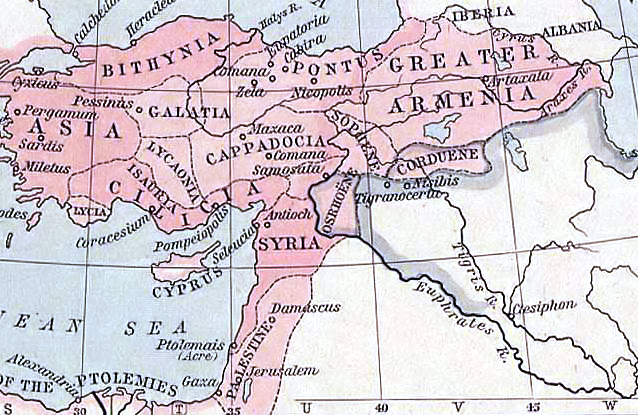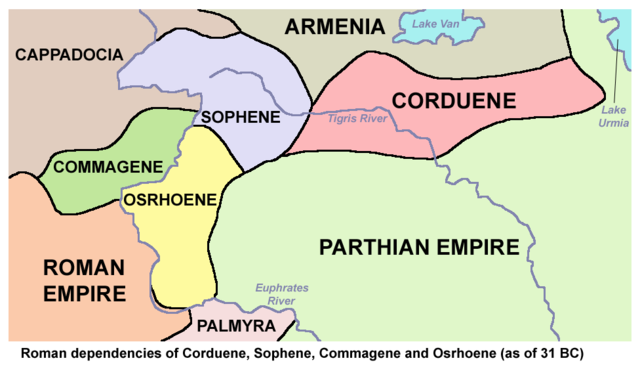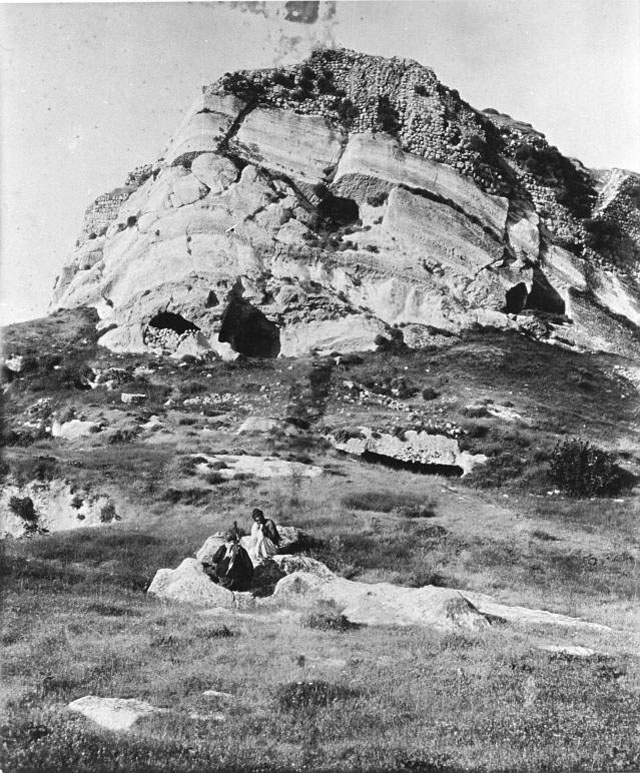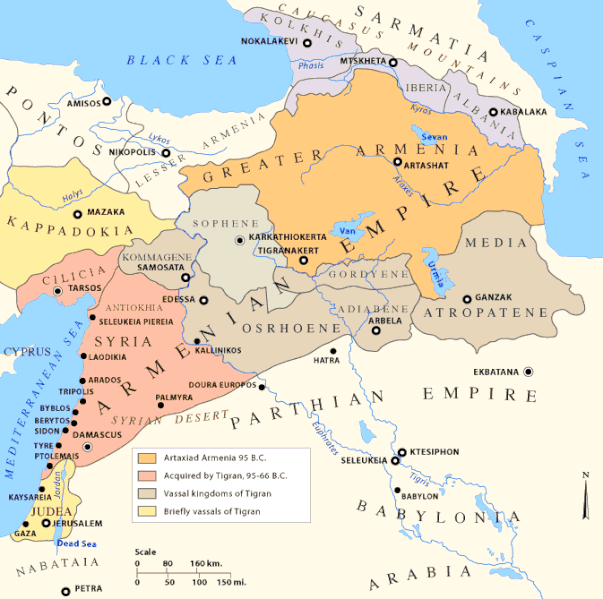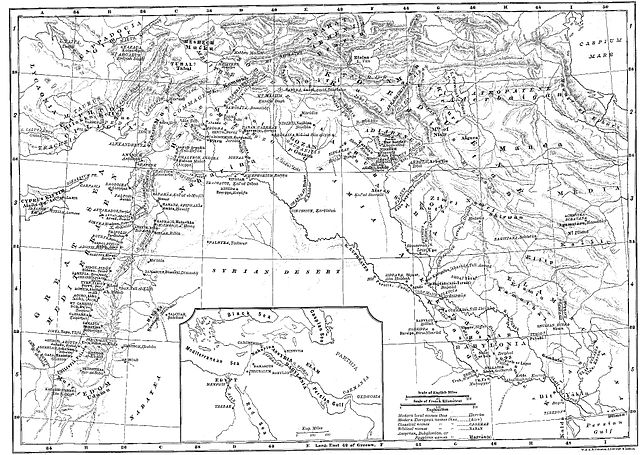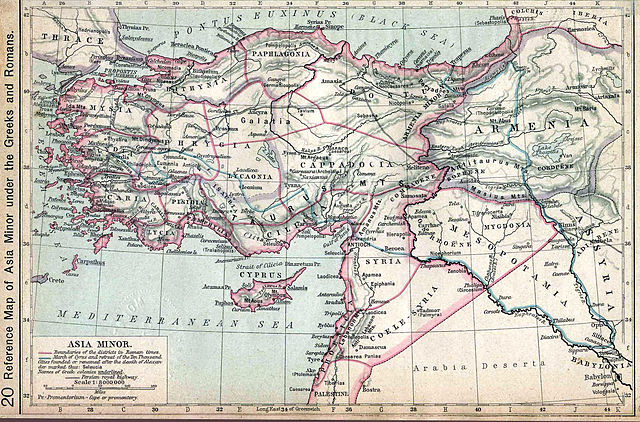
| CORDUENE
60 BC Kingdom of Corduene Corduene (also known as Gorduene, Cordyene, Cardyene, Carduene, Gordyene, Gordyaea, Korduene, Gordian; Armenian: Korchayk; Greek: Kordyene) was an ancient region located south of Lake Van, present-day eastern Turkey.
According to the 1911 Encyclopædia Britannica, Gordyene is the ancient name of the region of Bohtan (now Sirnak Province). It is mentioned as Beth Qardu in Syriac sources and is described as a small vassal state between Armenia and Persia in the mountainous area south of Lake Van in modern Turkey Corduene must also be sought on the left bank of the Tigris.
It has been cited as the country of the Carduchians, a fertile mountainous district, rich in pasturage. The Kingdom of Gordyene emerged from the declining Seleucid Empire and for most of its history, it was a province of the Roman Empire and acknowledged the sovereignty of Rome. From 189 to 90 BC, it enjoyed a period of independence. The people of Gordyene were known to have worshiped the Hurrian sky God Teshub.
Origins
:
A direct Gutian connection, however, is unlikely, as the Gutians were not Indo-Iranians and only known to have lived in southern Mesopotamia.
Carduchoi
in Xenophon :
They have been also mentioned as Gordi by Hecataeus of Miletus c. 520 BC.
Korduk'
in Armenian sources :
Corduene
in Jewish sources :
Jewish sources trace the origins of the people of Corduene to the marriage of Jinns of King Solomon with 500 beautiful Jewish women.
Corduene in Roman sources :
Castle of Pinaca (or Finik), northwest of Cizre According to the Greek historian and geographer Strabo, the region of Gorduene ("Gordyaean Mts") referred to the mountains between Diyarbakir and Mus. He recorded its main cities as Sareisa, Satalca and Pinaca (northwest of Bezabde), and considered its inhabitants (Gordyaeans) as descendants of the ancient Carduchians. According to him, the inhabitants had an exceptional repute as master-builders and as experts in the construction of siege engines and for this reason Tigranes used them in such work; he also notices the country for its naphtha resources.Ammianus Marcellinus visited this region while on a diplomatic visit to the satrap of Corduene. Eretrians who were exiled and deported by the Persians to Mesopotamia, were said to have taken up their dwelling in the region of Gordyene.
According to Strabo the Gordyaeans received their name from Gordys son of Triptolemus, who assisted in searching after Io, and then settled in Gordyaea district of Phrygia.
Pompey and Corduene :
Roman dependency of Corduene (as of 31 BC)
Castle of Pinaca (or Finik), northwest of Cizre Both Phraates III and Tigranes the Great laid claim to this province. However, it was conquered by the Roman troops under Pompey. The local population (called Gordyeni) did not defend the Armenian rule since according to Plutarch, Tigranes had demolished their native cities and had forced them into exile in Tigranocerta. In 69 BC, Zarbienus, the king of Corduene, was secretly planning for a revolt against Tigranes. He was negotiating with Appius Claudius for Roman help. However the plan was revealed and he was killed by Tigranes. After this, Lucullus raised a monument to Zarbienus and then he took over the region of Corduene. He took part in the funeral of Zarbienus, offered royal robes, gold and the spoils (taken from Tigranes), and called him his companion and confederate of the Romans.
After Pompey's success in subjugating Armenia and part of Pontus, and the Roman advance across the Euphrates, Phraates was anxious to have a truce with the Romans. However, Pompey held him in contempt and demanded back the territory of Corduene. He sent envoys, but after receiving no answer, he sent Afranius into the territory and occupied it without a battle. The Parthians who were found in possession were driven beyond the frontier and pursued even as far as Arbela in Adiabene. According to an inscription dedicated to the temple of Venus, Pompey gave protection to the newly acquired territory of Gordyene.
Armenian presence :
Map showing Corduene as a vassal Kingdom of Armenian Empire Tigran retained Gordyene and Nisibis, which Pompeius withheld from the Parthians. Gordyene belonged to Urartu for about 200 years and to Armenia for about 250 years.
While the Parthian dynasty was being weakened by dynastic feuds Tigranes extended his power by the annexation of Sophene and the Submission of Gordyene under its prince.
Districts of Cordyene under Armenian period were :
Korduq
(or Korduk), Kordiq Nerkin, Kordiq Verin, Kordiq Mijin, Tshauk,
Aitvanq, Vorsirank (or Orsirank), Aigarq, Motolanq, Kartuniq, Albag.
Following the defeat of Narseh, the Sassanid King, at the hands of the Romans in 296, a peace treaty was signed between the two sides, according to which the steppes of northern Mesopotamia, with Singara and the hill country on the left bank of the Tigris as far as Gordyene (Corduene), were also ceded to the victors (Romans).
The name of the province appears again in the account of the campaign between the Persians led by Shapur II and the Romans led by Julian the Apostate (and after Julian's death, by Jovian). The Romans started to retreat through Corduene after they could not besiege Ctesiphon.
Shapur's campaign against Corduene :
Korduene in northern and northeastern Mesopotamia; map from the Encyclopaedia Biblica In the spring of 360, Shapur II staged a campaign to capture the city of Singara (probably modern Shingar or Sinjar northwest of Mosul). The town fell after a few days of siege. From Singara, Shapur directed his march almost due northwards, and leaving Nisibis unassailed upon his left, proceeded to attack the strong fort known indifferently as Pinaca (Phaenicha) or Bezabde. This was a position on the east bank of the Tigris, near the point where that river quits the mountains and debouches upon the plain; though not on the site, it may be considered the representative of the modern Jezireh (Cizre in southeastern Turkey), which commands the passes from the low country into the Kurdish mountains. It was much valued by Rome, was fortified in places with a double wall, and was guarded by three legions and a large body of Kurdish archers. Shapur sent a flag of truce to demand a surrender, joining with the messengers some prisoners of high rank taken at Singara, lest the enemy should open fire upon his envoys. The device was successful; but the garrison proved staunch, and determined on resisting to the last. After a long siege, the wall was at last breached, the city taken, and its defenders indiscriminately massacred.
In 363, a treaty was signed in which Jovian ceded five provinces beyond the Euphrates including Corduene and Arzanene and towns of Nisibis and Singara to the Sassanids. Following this treaty, Greeks living in those lands emigrated due to persecution of Christians at the hands of Shapur and the Zoroastrians.
Corduene was a bishop's see since at least 424.
In
the 6th and 7th centuries :
List
of rulers :
Map showing kingdoms of Corduene and Adiabene in the last centuries BC. The blue line shows the expedition and then retreat of the ten thousand through Corduene in 401 BC 19th-century scholars, such as George Rawlinson, identified Corduene and Carduchi with the modern Kurds, considering that Carduchi was the ancient lexical equivalent of "Kurdistan". Jamie Stokes, Encyclopedia of the Peoples of Africa and the Middle East, Volume 1, Infobase Publishing, 2009, ISBN 978-0-8160-7158-6, p. 382. This view is supported by some recent academic sources which have considered Corduene as proto-Kurdish or as equivalent to modern-day Kurdistan.
Other modern scholars reject a Kurdish connection.
There were numerous forms of this name, partly due to the difficulty of representing kh in Latin. The spelling Karduchoi is itself probably borrowed from Armenian, since the termination -choi represents the Armenian language plural suffix -k'.
It is speculated that Carduchi spoke an Old Iranian language.
Timeline
of the history of Corduene (Gordyene) :
Source :
https://en.wikipedia.org/ |
